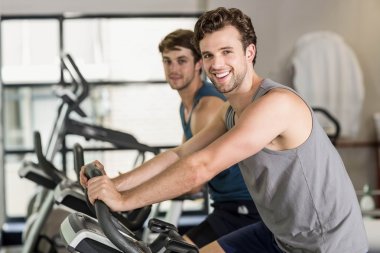
How Many Calories Can I Burn On Exercise Bike (7 Helpful Tips)
How many calories can I burn on exercise bike. This common question highlights the growing interest in maximizing workout efficiency and understanding the impact of exercise on overall health and fitness. Imagine a piece of equipment that not only revs up your heart rate but also ignites a calorie-burning bonfire, all from the comfort of your home.
The exercise bike, a staple in fitness regimens worldwide, offers a powerful workout capable of torching calories at an impressive rate. Whether you’re pedaling through a high-intensity interval session or enjoying a steady, scenic ride, the exercise bike adapts to your pace and effort, turning every pedal stroke into a step towards your fitness goals. But just how many calories can you actually burn on this versatile machine? The answer might just surprise and motivate you to hop on and start spinning those wheels.

How Many Calories Can I Burn On Exercise Bike
Calories Burned on an Exercise Bike: Unveiling the Science
Ever pondered how many calories you can torch during a sweat-inducing session on the exercise bike? The answer lies in a combination of factors including your weight, intensity of workout, duration, and even your metabolism. On average, a vigorous 30-minute session can burn anywhere from 200 to 600 calories, depending on these variables.
Weight Matters: The Impact on Calorie Burn
Your body weight plays a significant role in determining how many calories you’ll burn on the exercise bike. Heavier individuals typically burn more calories due to the increased effort required to move their mass. Conversely, lighter individuals may burn fewer calories for the same duration and intensity of exercise.
Intensity: Crank Up the Burn
The intensity of your workout session is another crucial factor. Higher resistance levels and faster pedaling speed can ramp up calorie burn significantly. Incorporating interval training or high-intensity interval training (HIIT) into your routine can also spike your calorie expenditure, even after you’ve finished your workout.
Duration: Longer Isn’t Always Better
While longer sessions on the exercise bike can indeed burn more calories, it’s essential to strike a balance. Overdoing it can lead to burnout or injury. Aim for a duration that challenges you without pushing you beyond your limits. Consistency is key for sustainable weight loss and fitness goals.
Metabolism: Your Body’s Engine
Your metabolism, influenced by factors like age, gender, and genetics, also impacts calorie burn. While you can’t control your metabolism entirely, regular exercise, including cycling on an exercise bike, can boost it over time. Building muscle through resistance training can further enhance your metabolic rate, leading to more efficient calorie burning.
Factors Influencing Calorie Burn
Individual factors
Calorie burn is influenced by several individual factors, including body weight, age, gender, fitness level, and basal metabolic rate (BMR). Heavier individuals generally burn more calories, as their bodies require more energy to perform the same activities. Age also plays a role; metabolic rate typically decreases with age, leading to a slower calorie burn.
Gender influences calorie expenditure due to differences in muscle mass and hormonal balances; men usually have more muscle mass, which burns more calories than fat tissue. Fitness level is another critical factor; those who are more fit often have a higher muscle-to-fat ratio and a more efficient metabolism, leading to increased calorie burn. Lastly, BMR, the amount of energy expended while at rest, varies from person to person and is determined by genetic factors, body composition, and overall health, directly impacting the number of calories burned throughout the day.
Exercise-related factors
The number of calories burned during exercise is influenced by several exercise-related factors. One of the most critical factors is the intensity of the workout, which can be categorized into low, moderate, and high intensity. High-intensity workouts generally burn more calories in a shorter amount of time compared to low and moderate intensity sessions. The duration of the workout also plays a significant role, as longer sessions increase overall calorie expenditure.
The type of exercise bike used impacts calorie burn, with resistance settings allowing for greater exertion and ergonomic design ensuring efficient energy use. Additionally, cycling speed influences the rate of calorie burn, with faster speeds leading to higher energy expenditure. Finally, interval training, which alternates between high-intensity bursts and low-intensity recovery periods, typically results in greater calorie burn compared to steady-state cardio, where the intensity remains constant throughout the session.
Calculating Calorie Burn
Formulas and equations
Calculating calorie burn involves understanding and utilizing specific formulas and equations tailored to various physical activities. The basic calorie burn formula generally factors in an individual’s weight, the duration of the activity, and a constant that represents the activity’s intensity. This formula is often expressed as: Calories burned = (Weight in kg) x (MET value) x (Duration in hours).
METs, or Metabolic Equivalent of Task values, are essential for determining the energy expenditure of different activities. They represent the ratio of the working metabolic rate to the resting metabolic rate. For instance, cycling has varying MET values depending on the intensity: leisurely cycling at a pace of less than 10 mph has a MET value of around 4, moderate cycling at 10-12 mph has a MET value of approximately 6, and vigorous cycling at 14-16 mph has a MET value of around 10.
By plugging the appropriate MET value for cycling into the basic calorie burn formula, individuals can accurately estimate the number of calories they burn during their cycling sessions. This approach allows for a tailored and precise calculation, facilitating better planning for fitness and dietary goals.
Tools and devices
Calculating calorie burn has become increasingly precise and accessible thanks to a variety of tools and devices designed to track and analyze physical activity. Heart rate monitors, which measure the heart’s beats per minute, can estimate calorie expenditure by correlating heart rate with energy usage during different types of exercise.
Fitness trackers and smartwatches, like those from Fitbit, Garmin, and Apple, combine heart rate data with motion sensors to provide a comprehensive picture of daily activity and calorie burn. Exercise bikes and other gym equipment often feature built-in displays that use algorithms based on speed, resistance, and user input data (such as weight and age) to estimate calories burned during a workout.
Additionally, online calculators and mobile apps, such as MyFitnessPal and MapMyRun, allow users to log their activities and receive estimates of calorie burn based on the type and duration of exercise. These tools leverage vast databases and sometimes integrate with wearable devices to provide tailored feedback, making it easier than ever to monitor and optimize fitness routines.

Examples of Calorie Burn Based on Different Scenarios
Low-intensity workout
Calorie burn varies significantly based on the intensity of the workout and the individual’s body weight. For example, a low-intensity workout such as a leisurely walk at a pace of 2 mph or light yoga can provide different calorie burn outcomes for individuals of different weights. A 150-pound person can expect to burn approximately 90-100 calories during a 30-minute session of such low-intensity activity.
In contrast, a 200-pound person will burn more calories in the same time frame, typically around 120-135 calories. This difference is due to the increased energy expenditure required to move a larger body mass. These values underscore the importance of considering both the nature of the activity and individual body weight when estimating calorie burn, as heavier individuals tend to expend more calories for the same duration and intensity of exercise compared to their lighter counterparts.
Moderate-intensity workout
When it comes to calorie burn, moderate-intensity workouts offer a variety of scenarios based on factors like duration and body weight. For instance, let’s consider a 30-minute session for both a 150-pound person and a 200-pound person. For the 150-pound individual, this moderate-intensity workout might torch around 180 to 250 calories, depending on the specific activity engaged in, such as brisk walking or cycling.
Meanwhile, for the 200-pound person, the calorie burn could range from 240 to 330 calories for the same duration and activity level. This discrepancy is largely due to the higher energy expenditure required for the heavier person to move their body through space. These examples highlight the personalized nature of calorie burn, demonstrating that factors like weight significantly influence the amount of energy expended during exercise.
High-intensity workout
High-intensity workouts can lead to significant calorie burns, especially when factoring in variables like weight. For instance, in just 30 minutes, a 150-pound person engaging in high-intensity exercises such as circuit training or HIIT (High-Intensity Interval Training) can burn approximately 300-400 calories. On the other hand, a 200-pound person doing the same workout for the same duration might burn around 400-500 calories due to their higher weight requiring more energy expenditure. This discrepancy highlights how individual factors, such as weight, play a crucial role in determining calorie burn during exercise.
Interval training session
An interval training session can be an effective and time-efficient way to burn calories. During a 20-minute session, you might alternate between high-intensity exercises, such as sprinting or high-knee running, and low-intensity activities, like walking or slow jogging. For instance, you could sprint for 30 seconds, followed by 1 minute of walking, and repeat this cycle for the duration of the workout.
This method of alternating intensity levels maximizes calorie burn both during and after the workout due to the afterburn effect, where your body continues to burn calories at a higher rate post-exercise. Depending on factors like your weight, fitness level, and intensity of the exercises, you could burn anywhere from 200 to 400 calories in this short, high-impact session. The high-intensity intervals elevate your heart rate significantly, while the low-intensity phases allow for brief recovery, making the workout more sustainable and effective over time.
Maximizing Calorie Burn
Increasing workout intensity
Maximizing calorie burn during workouts involves strategically increasing the intensity of your exercise routine. One effective method is to adjust the resistance settings on your equipment, such as stationary bikes or ellipticals, to higher levels. This forces your muscles to work harder, leading to greater energy expenditure.
Additionally, maintaining a faster cycling speed can significantly boost calorie burn by elevating your heart rate and enhancing cardiovascular fitness. To further amplify your efforts, incorporate sprints and interval training into your sessions. These high-intensity bursts, followed by short recovery periods, not only increase your overall workout intensity but also stimulate metabolism, allowing you to continue burning calories even after your workout is complete. Combining these strategies creates a dynamic and challenging exercise routine that maximizes calorie expenditure and improves overall fitness.

Extending workout duration
Maximizing calorie burn involves strategic approaches that extend beyond just the intensity of exercise. Extending workout duration can be an effective method to achieve this goal. First, opting for longer sessions provides an opportunity to engage in sustained physical activity, allowing the body to tap into its energy reserves more extensively. Whether it’s a lengthened cardio session or an extended strength training routine, the extra time spent exercising translates to increased calorie expenditure.
Additionally, incorporating multiple sessions per day can further amplify calorie burn. Breaking up workouts into smaller, manageable chunks not only keeps the metabolism revved up throughout the day but also prevents fatigue from setting in too quickly. This approach allows individuals to fit exercise into busy schedules while still reaping the benefits of heightened calorie expenditure. By extending workout duration through longer sessions and multiple bouts of exercise, individuals can optimize their calorie burn and progress towards their fitness goals more efficiently.
Cross-training
Maximizing calorie burn through cross-training involves integrating various forms of exercise into your routine, capitalizing on their unique benefits. Cycling, renowned for its cardiovascular advantages, can be enhanced by incorporating strength training. By engaging in strength exercises, you not only build muscle mass but also boost your metabolism, leading to increased calorie burn even at rest.
Moreover, the synergy between cycling and strength training fosters a well-rounded fitness regimen, targeting different muscle groups and preventing overuse injuries. This cross-training approach not only maximizes calorie expenditure during workouts but also promotes long-term weight management and overall health. Striking a balance between aerobic activities like cycling and strength exercises creates a powerful formula for achieving optimal fitness levels and enhancing your body’s calorie-burning potential.
Practical Tips for Effective Workouts
Setting realistic goals
Setting realistic goals is fundamental to effective workouts. Establishing objectives that align with your current fitness level, lifestyle, and schedule ensures sustainable progress. Begin by defining specific, measurable, attainable, relevant, and time-bound (SMART) goals tailored to your individual needs. Whether aiming to increase strength, improve endurance, or enhance flexibility, breaking down larger objectives into smaller milestones helps maintain motivation and track progress. Regularly reassessing and adjusting goals based on your evolving fitness journey ensures continuous improvement and prevents stagnation. By setting realistic expectations, you set yourself up for success and pave the way for a fulfilling workout experience.
Consistency and progression
Consistency and progression are the cornerstones of effective workouts. Consistently showing up and putting in the effort, even on days when motivation wanes, is crucial for long-term success. Establishing a routine and sticking to it helps create momentum and habituation, making it easier to stay committed over time.
Moreover, progression is key to continually challenging your body and seeing results. This can be achieved by gradually increasing the intensity, duration, or complexity of your workouts. Tracking your progress, whether it’s through keeping a workout journal, using fitness apps, or setting specific goals, allows you to measure your advancements and adjust your routine accordingly. Remember, small, incremental changes over time can lead to significant improvements in strength, endurance, and overall fitness.
Proper warm-up and cool-down routines
Effective workouts begin with proper warm-up and end with a thorough cool-down routine. Prior to diving into the main exercises, it’s crucial to dedicate time to warming up the body, which helps prepare muscles, joints, and the cardiovascular system for the upcoming intensity. A dynamic warm-up, consisting of movements like arm circles, leg swings, and light jogging, not only increases blood flow but also enhances flexibility and reduces the risk of injury.
Similarly, a well-executed cool-down is just as essential. It allows the heart rate to gradually return to its resting state, prevents muscle soreness, and promotes flexibility gains. Incorporating static stretches targeting major muscle groups such as quadriceps, hamstrings, and calves during the cool-down helps in maintaining flexibility and aids in muscle recovery. By prioritizing both warm-up and cool-down routines, individuals can optimize their workout sessions, improve performance, and safeguard their overall fitness journey.
Maintaining proper form and posture
Maintaining proper form and posture is fundamental for effective workouts, ensuring not only optimal results but also preventing injuries. Begin by familiarizing yourself with the correct form for each exercise you perform, whether it’s a squat, deadlift, or bicep curl. Pay close attention to alignment, keeping your spine neutral and engaging your core muscles to support your movements. Start with lighter weights if necessary to focus on technique before gradually increasing intensity. Utilize mirrors or training partners to check your form periodically and make necessary adjustments.
Additionally, prioritize quality over quantity, concentrating on controlled, deliberate movements rather than rushing through repetitions. Remember to breathe steadily and rhythmically throughout each exercise, inhaling during the eccentric phase and exhaling during the concentric phase. Lastly, listen to your body and don’t push through pain or discomfort—know when to rest and recover to prevent overuse injuries. By prioritizing proper form and posture in your workouts, you’ll maximize effectiveness while minimizing the risk of injury, allowing you to achieve your fitness goals safely and efficiently.
Hydration and nutrition considerations
To optimize your workouts, it’s crucial to pay attention to both hydration and nutrition. Hydration is key; aim to drink water consistently throughout the day, not just during your workouts. Start your session well-hydrated and continue to sip water throughout to replace fluids lost through sweat. As for nutrition, ensure you’re fueling your body with a balanced diet rich in lean proteins, complex carbohydrates, healthy fats, and plenty of fruits and vegetables.
Pre-workout snacks or meals should provide sustained energy, while post-workout nutrition should focus on replenishing glycogen stores and aiding muscle repair with a mix of protein and carbohydrates. Experiment with timing to find what works best for your body; some may prefer to eat a full meal a couple of hours before working out, while others may opt for a smaller snack closer to exercise time. Remember, consistency is key, so find a routine that supports your fitness goals and stick with it.
Potential Risks and Precautions
Overtraining and burnout
Overtraining and burnout pose significant risks to athletes, fitness enthusiasts, and individuals engaged in rigorous physical training. Pushing the body beyond its limits without adequate rest and recovery can lead to a myriad of negative consequences, both physical and mental. Physiologically, overtraining can result in chronic fatigue, decreased performance, increased risk of injury, and weakened immune function. Mentally, it can manifest as mood disturbances, irritability, lack of motivation, and even depression.
To mitigate these risks, it’s essential to prioritize rest and recovery periods within training schedules, incorporate variety in workouts to prevent monotony and overuse injuries, listen to the body’s signals, and adjust training intensity accordingly. Additionally, proper nutrition, hydration, and sufficient sleep are crucial for supporting the body’s ability to adapt and recover from training stress. Regular monitoring of training loads and incorporating deload weeks or periods of active recovery can also help prevent overtraining and burnout, ensuring sustainable progress and long-term health and performance.

Preventing injuries
Participating in cycling offers numerous health benefits, but it’s important to be mindful of potential risks and take precautions to prevent injuries. Firstly, ensuring correct bike setup is paramount. This involves adjusting the saddle height, handlebar position, and overall bike fit to match your body proportions and riding style. A poorly adjusted bike can lead to discomfort, muscle strain, and even more serious injuries over time.
Secondly, it’s crucial to adopt a gradual approach when increasing the intensity and duration of your rides. Pushing yourself too hard or too quickly can result in overuse injuries such as tendinitis or stress fractures. Instead, gradually increase the intensity and duration of your rides, allowing your body time to adapt and strengthen. Additionally, incorporating rest days into your training schedule is essential for recovery and injury prevention. By being proactive and attentive to these precautions, cyclists can enjoy their rides safely and minimize the risk of injuries.
Listening to your body
Understanding the potential risks associated with physical activity is crucial for maintaining a safe and effective fitness routine. One key precaution is listening to your body. This involves being attuned to signs of fatigue, such as muscle soreness, dizziness, or shortness of breath, which can indicate that you’re pushing yourself too hard. Recognizing these signals allows you to adjust your workouts accordingly, ensuring that you stay within your personal limits and avoid overexertion or injury. By prioritizing self-awareness and responsiveness, you can optimize your fitness regimen while minimizing the risk of harm.
FAQs About How Many Calories Can I Burn On Exercise Bike
Q1. How many calories can I burn on an exercise bike?
A. The number of calories burned on an exercise bike varies depending on factors like intensity, duration, your weight, and fitness level. On average, a person weighing 155 pounds can burn around 260-470 calories in 30 minutes of moderate cycling.
Q2. Does the resistance level on the exercise bike affect calorie burn?
A. Yes, higher resistance levels require more effort, thus burning more calories. Adjusting the resistance can make your workout more challenging and increase calorie expenditure.
Q3. Can I rely on the calorie counter on the exercise bike’s display?
A. While the calorie counter on the bike can provide a rough estimate, it may not be entirely accurate. Factors like individual metabolism and cycling technique can influence calorie burn. It’s best to use it as a reference rather than an absolute measurement.
Q4. How can I maximize calorie burn on the exercise bike?
A. To maximize calorie burn, try incorporating interval training by alternating between high-intensity intervals and recovery periods. Also, ensure proper posture and pedal at a consistent pace to engage more muscles and increase calorie expenditure.
Q5. Is it better to do longer sessions or shorter, more intense ones for calorie burn?
A. Both longer, moderate-intensity sessions and shorter, high-intensity sessions can effectively burn calories. The key is finding what works best for you and varying your workouts to prevent plateaus and maintain motivation.
Q6. Are there any specific techniques or workouts recommended for burning calories on the exercise bike?
A. Incorporating varied workouts like hill climbs, sprints, and endurance rides can help engage different muscle groups and maximize calorie burn. Additionally, mixing in upper body exercises or core workouts while cycling can increase overall calorie expenditure.
Q7. How does my weight affect calorie burn on the exercise bike?
A. Generally, the more you weigh, the more calories you’ll burn during exercise because it requires more energy to move a heavier body. However, weight isn’t the sole determinant; factors like fitness level and intensity of the workout also play significant roles.
Q8. Can I lose weight by solely using an exercise bike?
A. While regular cycling on an exercise bike can contribute to weight loss, it’s essential to complement it with a balanced diet and other forms of exercise for optimal results. A combination of cardiovascular exercise, strength training, and a healthy diet is typically recommended for sustainable weight loss.
Conclusion
Riding an exercise bike can be an effective way to burn calories and improve cardiovascular health. The number of calories burned depends on various factors, including your weight, intensity, and duration of the workout. On average, a person weighing 155 pounds can burn approximately 260 calories in 30 minutes of moderate cycling, while vigorous cycling can burn around 391 calories in the same duration. By adjusting the resistance and speed, you can tailor your workout to meet your fitness goals and maximize calorie expenditure. Incorporating regular sessions on an exercise bike into your fitness routine can significantly contribute to weight management and overall well-being.